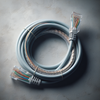
Shielded vs unshielded cat6a
January 31, 2024
Unveiling the Choice: Shielded vs. Unshielded Cat6a Cables

When it comes to high-performance networking, the selection between shielded and unshielded cables becomes a pivotal decision. Cat6a (Category 6a) cables, designed to support 10 Gigabit Ethernet over longer distances, are available in both shielded and unshielded variations. This article explores the differences between shielded and unshielded Cat6a cables, assisting network professionals in making informed choices based on their specific requirements.
Shielded Cat6a Cables:
- Electromagnetic Interference (EMI) Protection:
- Shielded Cat6a cables, often referred to as F/FTP (Foiled Twisted Pair) or S/FTP (Shielded and Foiled Twisted Pair), feature an additional layer of shielding. This shielding acts as a barrier against electromagnetic interference (EMI), making shielded Cat6a cables suitable for environments with high levels of interference, such as industrial settings or areas with numerous electronic devices.
- Enhanced Signal Integrity:
- The shielding in Cat6a cables helps minimize crosstalk and external interference, ensuring enhanced signal integrity. This can be particularly beneficial in scenarios where maintaining the highest level of data transmission quality is critical.
- Higher Cost:
- Shielded Cat6a cables, due to the added shielding materials and construction, tend to be more expensive compared to their unshielded counterparts. However, the investment may be justified in environments where EMI protection is paramount.
Unshielded Cat6a Cables:
- Cost-Effective Solution:
- Unshielded Cat6a cables, known as U/FTP (Unshielded Twisted Pair) or U/UTP (Unshielded and Unscreened Twisted Pair), provide a cost-effective solution for high-speed data transmission. They are well-suited for environments with lower levels of electromagnetic interference.
- Flexibility and Ease of Installation:
- Unshielded Cat6a cables offer flexibility and ease of installation. The absence of additional shielding makes them more pliable and straightforward to work with, facilitating installation in various networking setups.
- Sufficient for Many Environments:
- In environments where EMI is not a significant concern, such as standard office spaces or residential installations, unshielded Cat6a cables often provide more than adequate performance.
Choosing Between Shielded and Unshielded Cat6a Cables:
- Environment and Application:
- Consider the environment where the cables will be installed. Shielded Cat6a cables are ideal for environments with high EMI, while unshielded Cat6a cables are suitable for standard office or residential use.
- Budget Constraints:
- Assess the budget constraints of the project. Shielded Cat6a cables are generally more expensive, so weighing the necessity of shielding against budget considerations is essential.
- Installation Ease:
- Evaluate the ease of installation required for the project. Unshielded Cat6a cables are often preferred in installations where flexibility and ease of routing are critical.
The choice between shielded and unshielded Cat6a cables hinges on the specific demands of the networking environment. By considering factors such as EMI sensitivity, budget constraints, and installation requirements, network professionals can make informed decisions that align with the performance needs of their projects.

